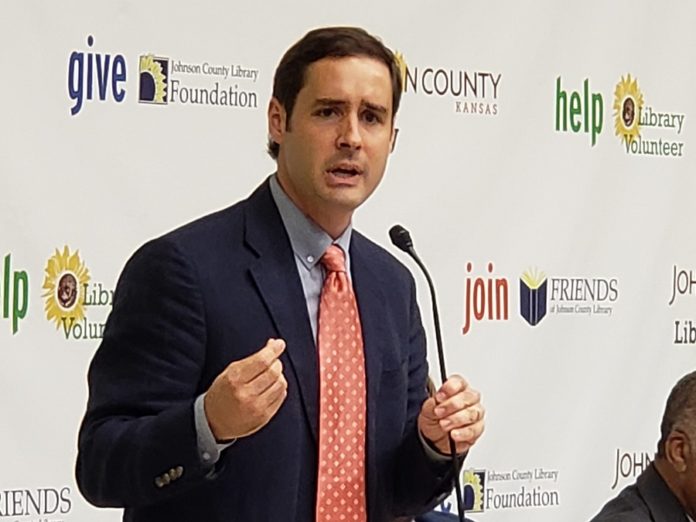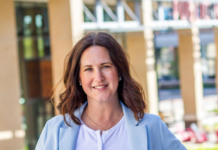Democrat Josh Svaty is gambling the Kansas governor’s race on a rare strategy in American politics.
As Democratic and Republican candidates flood the airwaves with hundreds of thousands of dollars in television ads, the Svaty campaign is conspicuously absent from the commercial wars.
If you’re looking for that iconic commercial from the Svaty campaign — like Lyndon B. Johnson’s “Daisy” from 1964 or George H.W. Bush’s Willie Horton from 1988 — it’s not going to be there.
The Svaty campaign is foregoing the power of television in the Democratic primary, instead waging the campaign on the algorithms of the internet, whether it’s Facebook, Twitter or the geo-targeting of select groups of voters.
It’s a high-risk bet, even in an era when candidates are spending millions more on digital advertising, an approach that offers the opportunity to more directly target voters by age, gender, hobbies, shopping habits and political leanings.
“It’s a ballsy strategy. It really is,” said Steve Passwaiter, vice president and general manager of Kantar Media’s Campaign Media Analysis Group. “What you’ve got here is a pretty interesting contrarian strategy.”
The Svaty campaign believes the money being poured into television for primary campaigns is wasted.
Mike Swenson, a top strategist for Svaty, said broad-based television ads reach for more people than what’s needed in a Democratic primary.
For instance, an ad in the Kansas City market means you’re paying for commercials beamed into Missouri where there are no Kansas voters and into Republican homes in Johnson County where there are no Democratic primary voters.

“We’re running a campaign that’s largely about how we can get our message out to the most targeted group of people that we think are the most likely voters,” Swenson said.
“You can say we’re cutting against the grain, or we’re establishing the new beachhead of what campaigns are going to look like and Kansans are just seeing one for the first time up close and personal.”
Clearly, digital advertising has opened a new door for political operatives trying to reach voters.
Various estimates place digital advertising spending on political campaigns somewhere from $600 million to more than $1 billion nationwide.
A recent report by the ad-tracking firm Borrell Associates estimates that digital spending on political ads has grown from about $70 million in 2014 to a projected $1.8 billion in 2018.
While that’s a hefty amount, it’s not replacing or even coming close to surpassing the amount of money spent on political television ads, even as viewers increasingly cut their cable cords in favor of internet offerings.
The Williamsburg, Va.-based firm estimated that digital advertising will only make up 20 percent of all political advertising this year.
Broadcast and cable television spending, estimated at $4.5 billion nationally, will make up about half of all political ad spending this year, according to Borrell.
Another 8 percent will go to radio and 7 percent will be put into newspapers, Borrell reports. In Kansas, television is expected to get 40 percent of all the money spent on political advertising.
“People still watch TV,” said Kip Cassino, executive vice president at Borrell and a market researcher spanning three decades.
“The question would be: Does he have a big enough reach without television to get enough people to the polls who are going to vote for him to win?” Cassino said of Svaty.
Cassino agreed that the political strategy is shifting from trying to persuade large numbers of voters and hoping some fraction will support you to narrowly focusing on segments of the voting population.
“The new idea that you should just target the people who you think are going to vote for you and others who look like that — that is the one that’s taking place, the shift from mass media to targeted media,” Cassino said.
While digital advertising may be more efficient in some ways than television ads, it’s more than just posting an ad or video on Facebook or Twitter and crossing your fingers, he said.
“If you’re going to contact people through digital media, you have to know a lot about them. You have to have done a pretty good amount of research on what kind of people are going to vote for you,” Cassino said.
“If you haven’t done that research, you really can’t use the digital platform very well.”
Just how much of that homework the Svaty campaign has done is unclear outside the inner workings of his political strategists.
Swenson would only say the campaign has had a digital team on staff for more than a year and that it’s targeting Democratic and unaffiliated voters.
“We have put an emphasis on digital and social investments to get the campaign message direct to key groups of voters. This is the beauty of the world we live in today,” he said. “We can speak to specific groups about the issues they care about the most.”
Here’s a look at a two-minute video the Svaty campaign produced. It was viewed about 2,100 times on Twitter.
Svaty’s Democratic rival state Sen. Laura Kelly is spending about $140,000 in television advertising. The campaign declined to discuss too many details of its strategy.
“We are using a wide range of digital strategies, in addition to television, to connect with voters across Kansas ahead of the Democratic primary,” spokeswoman Johanna Warshaw said.
Kelly’s first television ad posted on Twitter had a little more than 4,300 views on Twitter. Another video posted on Twitter after mocking comments about Kelly’s career path were written on Facebook was viewed almost 1,500 times.
Another Democratic rival, former Wichita Mayor Carl Brewer, has raised less money than Svaty but has been up on television, although not to the extent of Kelly. His campaign did not respond to questions about digital advertising.

On the Republican side, Gov. Jeff Colyer and Secretary of State Kris Kobach are employing a mix of both digital and television advertising in a race where the two combined could spend more than $3 million.
They arguably have a greater concentration of voters to reach than the Democrats, observers said.
“TV is still an important market,” Colyer spokesman Kendall Marr said. “It provides us a tremendous opportunity to get our message of strong conservative leadership in front of a large audience. To be successful, we think you need an all-of-the-above strategy.”
Kobach’s campaign manager, state Rep. J.R. Claeys, agreed.
“TV is still by far the primary source of news information for voters,” Claeys said in an email. “Since we have close ties to President Donald Trump, we want to reach voters who came out in 2016 for Trump, and broadcast TV gets our message in front of that audience.”

Some experts don’t write off the Svaty strategy as political suicide, noting that a primary focuses on a smaller, more defined group of voters.
“It’s not a completely foolish thing to do by any means,” said Travis Rideout, an expert in political communications at Washington State University.
“Sometimes candidates can get away with it,” he said. “If they’re well known, they can attract a lot of free media. It may not matter.”
But Svaty’s name identification hasn’t always been that high throughout the campaign.
A poll done in March by Fort Hays State University researchers showed that only about 20 percent of Kansans were familiar with Svaty, although it is unknown how that number may have changed in the last several months.
However, Rideout and others point out the downside to the Svaty approach.
He risks losing a segment of the population, especially older voters who watch broadcast television and go to the polls.
“There may be some segments of the population who’ve just never heard of you,” Rideout said. “The 65-year-old who’s watching ‘Wheel of Fortune,’ ‘Jeopardy’ and local news just isn’t seeing your ad, but they’re seeing the ads of all your opponents.”
The view was echoed by Passwaiter, who noted that midterm primaries tend to skew toward an older generation of voters.
“Do you run the risk of missing those frequent voters by doing a digital-only strategy?” Passwaiter asked. “That to me would seem to be the primary risk.”
Rideout also said that TV ads can be a sign of a candidate’s strength, something that would be lost without a television ad campaign.

“You start looking not as viable as the other candidates,” Rideout said. “That’s sometimes a metric people have used to assess the viability of a candidate.”
But looking over the campaign battlefield, experts say it’s a combination of weapons that leads to victory on Election Day.
Digital approaches such as Facebook and Twitter give candidates a more one-on-one relationship with voters. Television gives them a broad, quick strike approach for messaging.
“There are things digital advertising does extremely well, and there are other things that television advertising does well and maybe a little better,” Passwaiter said. “All of the different media are going to play different roles in these campaigns.”
Rideout broke it down this way:
“TV is great for getting a single message out to a lot of people. Digital is great getting those targeted messages out to particular groups of voters,” he said.
“But if there’s one campaign message you want to get out there … and you want to do it quickly,” he said, “TV is still useful for that.”
Swenson said the Svaty camp has tried to spend its limited resources – it raised about $400,000 for the campaign – so it gets the most out of each dollar spent.
“We knew from the very beginning we were going to be outspent and outraised,” Swenson said. “We had to run our campaign based on the knowledge that we were going to have use our resources as wisely as possible and be as targeted as possible. We’ll either be right or wrong.
“If we’re right, then everybody will go, ‘How did they do that without being on the almighty television?”
















